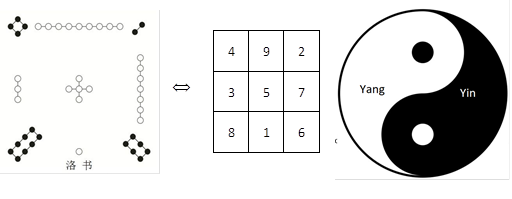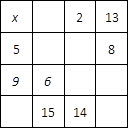A magic square is a ![]() square filled with
distinct positive numbers such that the sum of the integers in each row, column,
and diagonal is equal. The sum is called the magic constant.
As shown in Figure 2‑2, the
square filled with
distinct positive numbers such that the sum of the integers in each row, column,
and diagonal is equal. The sum is called the magic constant.
As shown in Figure 2‑2, the ![]() magic square can be traced back to HetuLuoshu (河图洛书),
a collection of ancient Chinese diagrams that are more famous for the first
chart of Ying and Yang. In the traditional definition of a magic square, the
numbers in the squares are natural numbers
magic square can be traced back to HetuLuoshu (河图洛书),
a collection of ancient Chinese diagrams that are more famous for the first
chart of Ying and Yang. In the traditional definition of a magic square, the
numbers in the squares are natural numbers ![]() Such a magic square is
also called normal magic square. Math problems use a generalized version of
magic squares. They allow numbers to be different from
Such a magic square is
also called normal magic square. Math problems use a generalized version of
magic squares. They allow numbers to be different from ![]()

Figure 2‑2 Magic square and Yin-Yang chart from HetuLuoshu
Figure 2‑3 shows a generalized version of 3 × 3 magic square.
|
|
|
|
|
|
|
|
|
|
|
|
Figure 2‑3 Generalized version of a magic square
Equation (1) to equation (8) show the expressions for the sums
of rows, columns, and diagonals. The sums are all equal to the magic number ![]() .
.
![]() (1)
(1)
![]() (2)
(2)
![]() (3)
(3)
![]() (4)
(4)
![]() (5)
(5)
![]() (6)
(6)
![]() (7)
(7)
![]() (8)
(8)
Let the sum of all numbers, ![]() be S, we can
derive the following properties from the equations:
be S, we can
derive the following properties from the equations:
1.
magic constant ![]() (sum of equation 1, 2, 3
shows
(sum of equation 1, 2, 3
shows ![]()
2.
![]() (sum of equation 2, 5,
7, 8 shows
(sum of equation 2, 5,
7, 8 shows ![]() )
)
3.
![]()
4.
![]() (the sum of equation 4
and 7 equals the sum of equation 2 and 3:
(the sum of equation 4
and 7 equals the sum of equation 2 and 3: ![]() ).
).
Similarly, we have ![]() and
and ![]()
The number at the center of the square must be the average of the 9 numbers. Each row, column, or diagonal adds up to 3 times the average. The number at the corner of the square is the average of the two numbers that are not in the same row, column, or diagonal of that number.
In general, the magic number in an ![]() magic square is the
average of the input numbers times
magic square is the
average of the input numbers times ![]() This follows from the
equation that the sum of
This follows from the
equation that the sum of ![]() rows (or
rows (or ![]() columns)
is the sum of all input numbers.
columns)
is the sum of all input numbers.
Problem 2‑42
In the following square, the sum of the numbers in each row,
column, and diagonal are equal. What is ![]() ?
?

Solution:
In this problem, 3 numbers are given. When these 3 numbers are not all in the
same row, column, or diagonal, all numbers in the square can be determined. Figure 2‑4 shows how to calculate the remaining numbers. Since the sum of the
first column is ![]() The sum of all three
rows, three columns, and two diagonals must be
The sum of all three
rows, three columns, and two diagonals must be ![]() In
the second row, the number in the center of the square must be
In
the second row, the number in the center of the square must be ![]() In
the top-left to bottom-right diagonal, the number at the bottom right must be
7. In the last column, the number in the first row must be
In
the top-left to bottom-right diagonal, the number at the bottom right must be
7. In the last column, the number in the first row must be ![]() Now
we have sufficient information to calculate
Now
we have sufficient information to calculate ![]() as
as
![]() We can go ahead to fill
in the rest of the numbers and verify that the sum of each row, column, and
diagonal is equal to 30.
We can go ahead to fill
in the rest of the numbers and verify that the sum of each row, column, and
diagonal is equal to 30.

Figure 2‑4 Derivation of a 3×3 magic square
Problem 2‑43
In the following square, the sums of the numbers in each row,
column, and diagonal are equal. What is ![]() ?
?

Solution:
The number at the corner of the square is the average of the two numbers that
are not in the same row, column, or diagonal of that number. Therefore, ![]() and
and ![]()
Problem 2‑44
In the following square, the sums of the numbers in each row,
column, and diagonal are equal. What is ![]() ?
?

Solution:
Since ![]() we have
we have ![]() The
number at the corner of the square is the average of the two numbers that are
not in the same row, column, or diagonal of that number:
The
number at the corner of the square is the average of the two numbers that are
not in the same row, column, or diagonal of that number:
![]()
Problem 2‑45
In the following ![]() magic square, the sums of
the numbers in each row, column, and diagonal are equal. The numbers in the
squares are
magic square, the sums of
the numbers in each row, column, and diagonal are equal. The numbers in the
squares are ![]() What is
What is ![]() ?
?

Solution:
The average of the numbers is ![]() Since the magic number
in an
Since the magic number
in an ![]() magic square is the
average of the input numbers times
magic square is the
average of the input numbers times ![]() each row, column, and
diagonal adds up to
each row, column, and
diagonal adds up to ![]() Using this observation,
we can fill in all the remaining cells in the square as expressions of
Using this observation,
we can fill in all the remaining cells in the square as expressions of ![]() (Figure 2‑5). Since the sum of the top-left to bottom-right diagonal is also 34,
we can calculate
(Figure 2‑5). Since the sum of the top-left to bottom-right diagonal is also 34,
we can calculate ![]() using the following
equation:
using the following
equation:
![]()

Figure 2‑5 Derivation of a 4×4 magic square